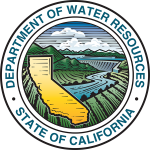Drought Continues Despite Early-Season Rainfall

Still early in California’s rainy season, the Department of Water Resources (DWR) announced its initial water allocation for 2017 of 20 percent of the requests by the 29 public agencies served by the State Water Project (SWP).
Winter storms in coming months may boost today’s initial 2017allocation, but California’s deep drought lingers.
“October’s storms and subsequent rainfall have brightened the picture, but we could still end up in a sixth year of drought,” said DWR Director Mark Cowin. “Our unpredictable weather means that we must make conservation a California lifestyle.”
Much of October’s heavy rainfall was soaked up by the state’s drought-dried soil, although water from subsequent storms will increase runoff into streams and reservoirs.
Initial allocations frequently change. For example, the initial allocation for this year (2016) was 10 percent, with a final allocation of 60 percent. DWR typically issues a final allocation in May, after the state’s wettest months have passed.
Lake Oroville in Butte County, the SWP’s principal reservoir, early this morning was holding 1,492,136 acre-feet, 42 percent of its 3.5 million acre-foot capacity and 70 percent of its historical average for the date. Shasta Lake north of Redding, California’s and the federal Central Valley Project’s (CVP) largest reservoir, was holding 2,896,484 acre-feet, 64 percent of its 4.5 million acre-foot capacity and 107 percent of its historical average. San Luis Reservoir, a critical south-of-Delta pool for both the SWP and CVP, was holding 814,972 acre feet, 40 percent of its 2 million acre-foot capacity and 67 percent of its historical average for the date.
The 29 public water agencies that receive SWP water collectively requested 4,172,786 acre-feet of water for 2017. Under today’s initial allocation, they would receive 839,376 AF. For most agencies, that amounts to 20 percent of the supplies for which they contract with DWR.
Nearly all areas served by the SWP have sources of water other than the DWR allocation, among them streams, groundwater and local reservoirs. DWR is hopeful that today’s SWP allocation, made before the wettest months, will increase as storms bring additional rain and snow to the state.
The last 100 percent SWP allocation – difficult to achieve even in wet years because of Delta pumping restrictions to protect threatened and endangered fish species – was in 2006. SWP allocations in recent years:
2016 – 60 percent
2015 – 20 percent
2014 – 5 percent
2013 – 35 percent
2012 – 65 percent
2011 – 80 percent
2010 – 50 percent
2009 – 40 percent
2008 – 35 percent
2007 – 60 percent
DWR’s California Data Exchange Center Web sites show current water conditions at the state’s largest reservoirs and weather stations.
Reservoirs: http://cdec.water.ca.gov/reservoir.html
Precipitation: http://cdec.water.ca.gov/snow_rain.html










